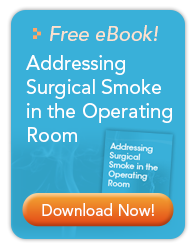 There seems to be a growing demand for using energy based surgical equipment, such as electrosurgery units (ESUs), lasers, harmonic scalpels and now cold plasma devices, to cut and/or remove affected patient tissues. These devices all generate heat at the tissue level and create smoke plumes, to a greater or lesser degree. Hospitals and surgery centers need to be sure that they are meeting health and safety requirements to protect their patients, surgeons and other OR staff members from the potentially hazardous effects of these smoke plumes. According to the Association of peri-Operative Registered Nurses (AORN), they should consider employing smoke evacuators as a comprehensive solution to augment the OR ventilation system and minimize the potentially hazardous smoke and gases generated by these devices. Smoke evacuators are an essential tool for protecting operating room staff and patients who may be at risk for inhaling the smoke created during these procedures.
There seems to be a growing demand for using energy based surgical equipment, such as electrosurgery units (ESUs), lasers, harmonic scalpels and now cold plasma devices, to cut and/or remove affected patient tissues. These devices all generate heat at the tissue level and create smoke plumes, to a greater or lesser degree. Hospitals and surgery centers need to be sure that they are meeting health and safety requirements to protect their patients, surgeons and other OR staff members from the potentially hazardous effects of these smoke plumes. According to the Association of peri-Operative Registered Nurses (AORN), they should consider employing smoke evacuators as a comprehensive solution to augment the OR ventilation system and minimize the potentially hazardous smoke and gases generated by these devices. Smoke evacuators are an essential tool for protecting operating room staff and patients who may be at risk for inhaling the smoke created during these procedures.
With more procedures taking place using energy based equipment, and even more likely in the future, here are three reasons why smoke evacuators are important for use in the OR.
1. Lower the risk of irritation/infection
Energy based surgical equipment uses electrical currents and tools to target and remove affected tissues. This generates heat at the tissue level and creates smoke. Of the surgical smoke plumes generated, the vast majority (95 percent) is water while the remaining 5 percent is made up of other matter. This other matter could be comprised of a variety of potentially harmful gases, vapors and dead or live cellular material. These materials, such as benzene, blood, tissue fragments and bacteria or viruses, are of very small size and pose the potential for irritation and/or infection. When healthcare workers are exposed to this smoke in high concentrations, the vapors could cause health effects, such as irritation or infection of the eyes and upper respiratory tract. Smoke evacuators can reduce the levels of dangerous smoke present in the OR during these procedures.
2. Decrease the noxious odor in the healthcare environment
These smoke plumes often create noxious odors which can be offensive to both patients and staff members. To address this, hospitals and surgery centers may need to install smoke evacuators. Generally, regular operating room ventilation will not suffice in extracting smoke plumes and the hazardous materials produced during procedures using energy based equipment. The National Institute for Occupational Safety and Health (NIOSH) recommends implementing smoke evacuators during electrosurgery. Supplementing regular room ventilation with local exhaust ventilation (LEV) systems like smoke evacuators helps ensure a sterile healthcare environment because they target the smoke within the workplace and remove it before it enters the workers' breathing space.
3. Capture the visual airborne contaminants
With the risk of airborne contaminants, NIOSH suggests that healthcare employers could install air purification equipment with high quality filters, such as a high efficiency particulate air (HEPA) filters. There are also higher performance filters like Ultra Low Penetration Air (ULPA) grade filters, which will improve filtration compared to a HEPA filter, to capture particulates generated by energy based equipment, and enhance the quality of the air in the workplace.
The Bovie Medical Corporation is pleased to be able to aid healthcare facilities in facing the daily challenge of providing workers and patients with a clean and safe environment by providing the Smoke Shark II smoke evacuator. The Smoke Shark II features a lightweight and compact design that supplies superior performance to remove noxious smoke plume gases and particulates. The Smoke Shark II smoke evacuator captures particulate matter and micro-organisms as small as 0.1 - 0.2 microns quietly and effectively.
Courtesy Photo Via: cooldesign/freedigitalphotos.net




